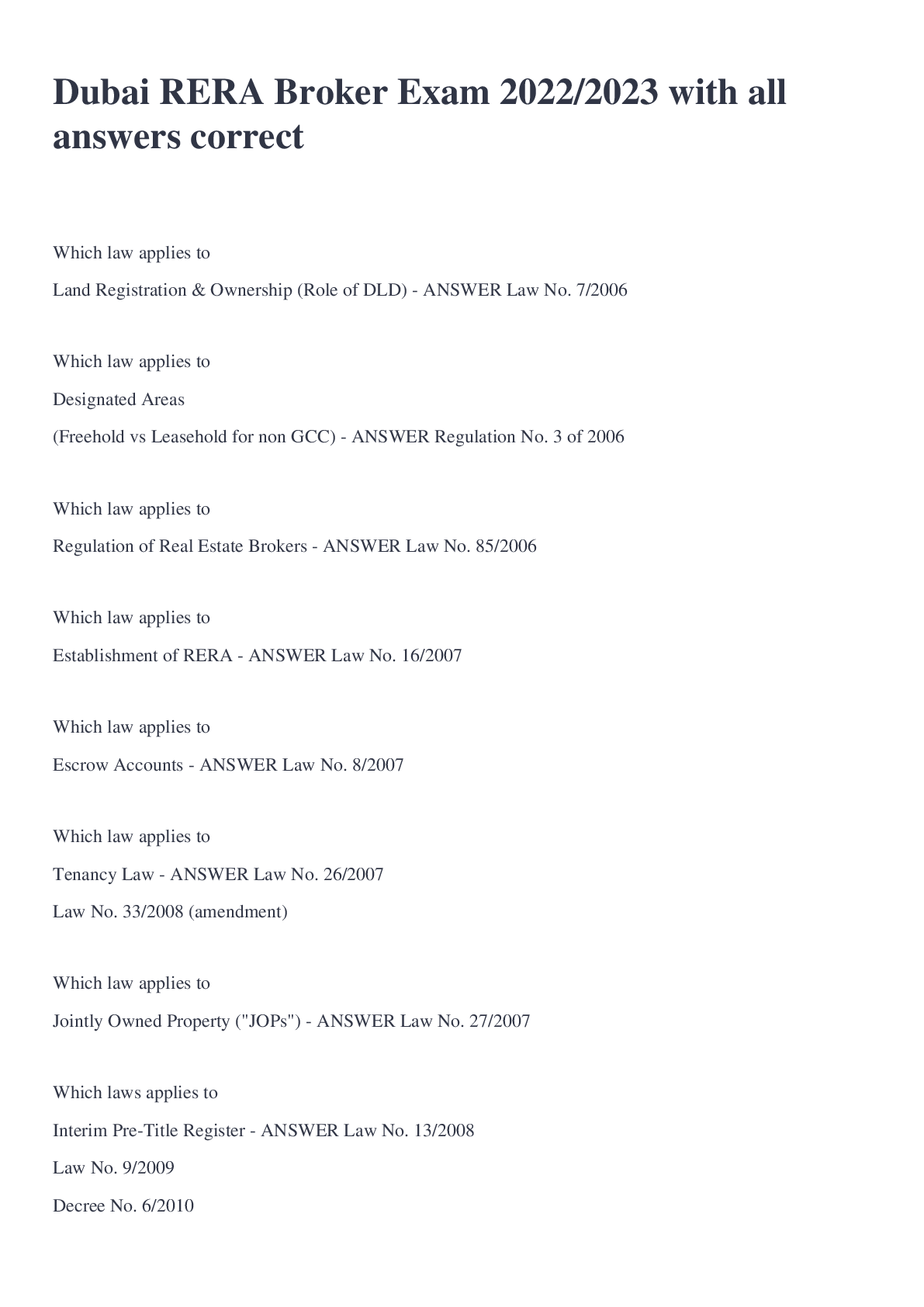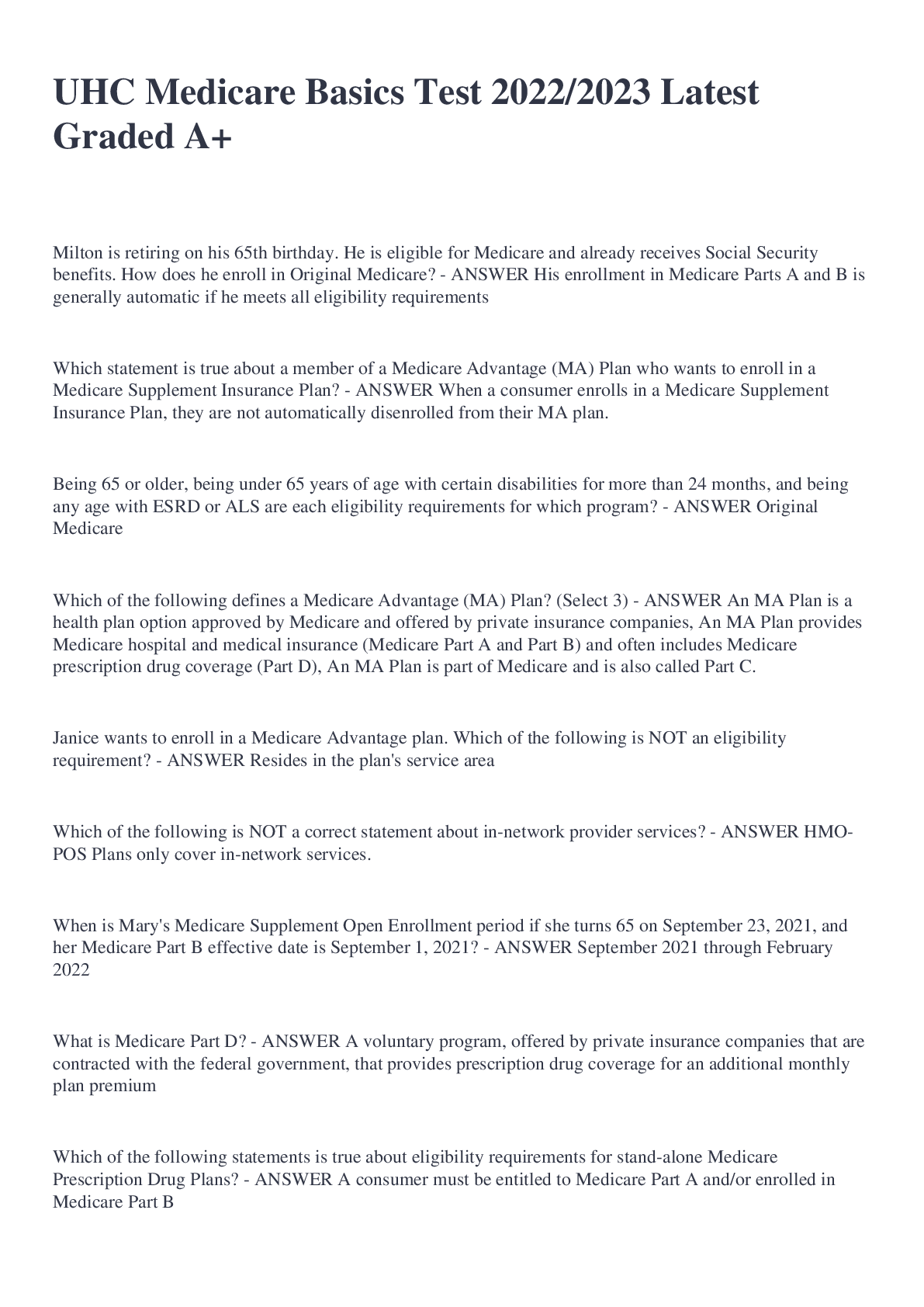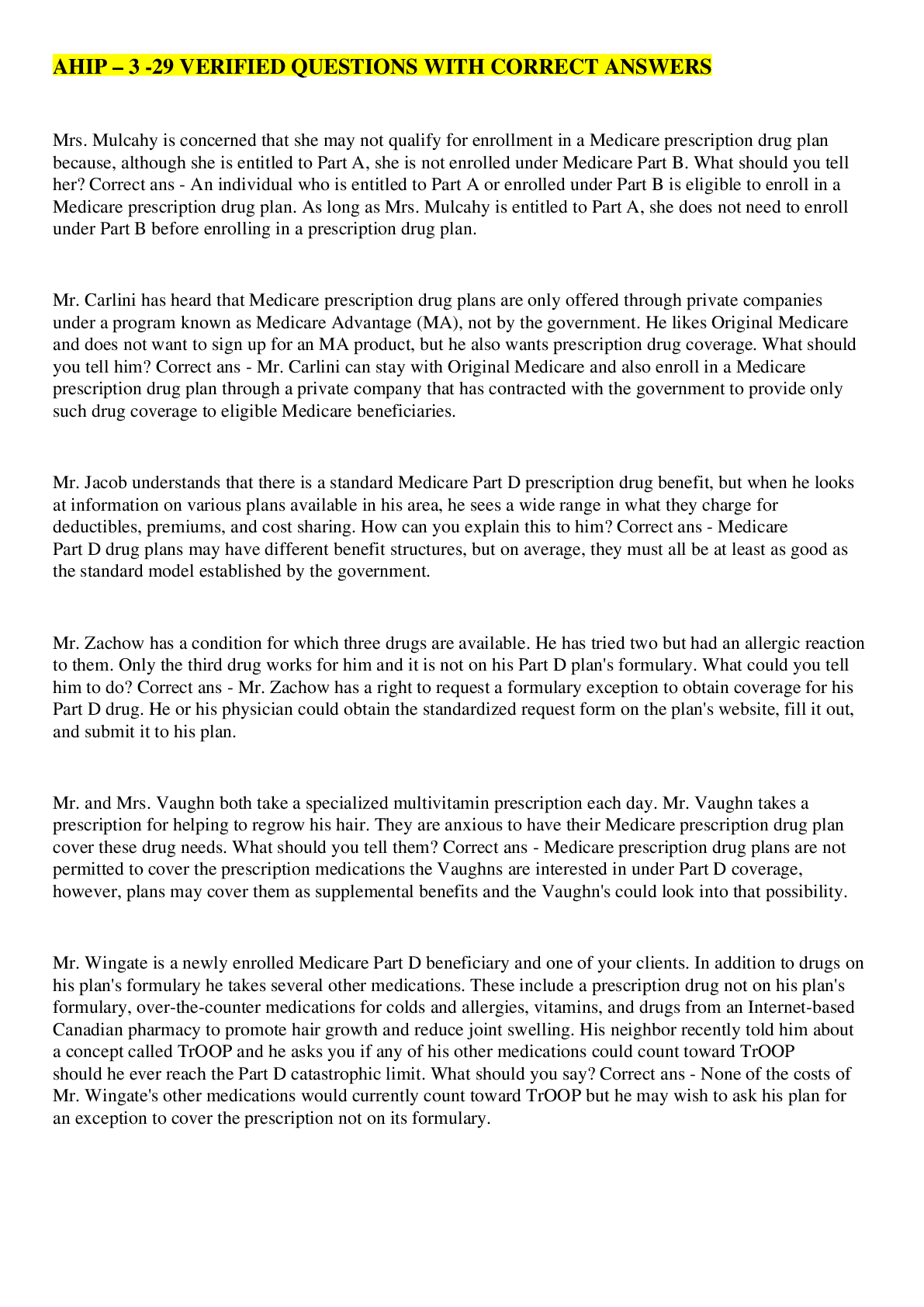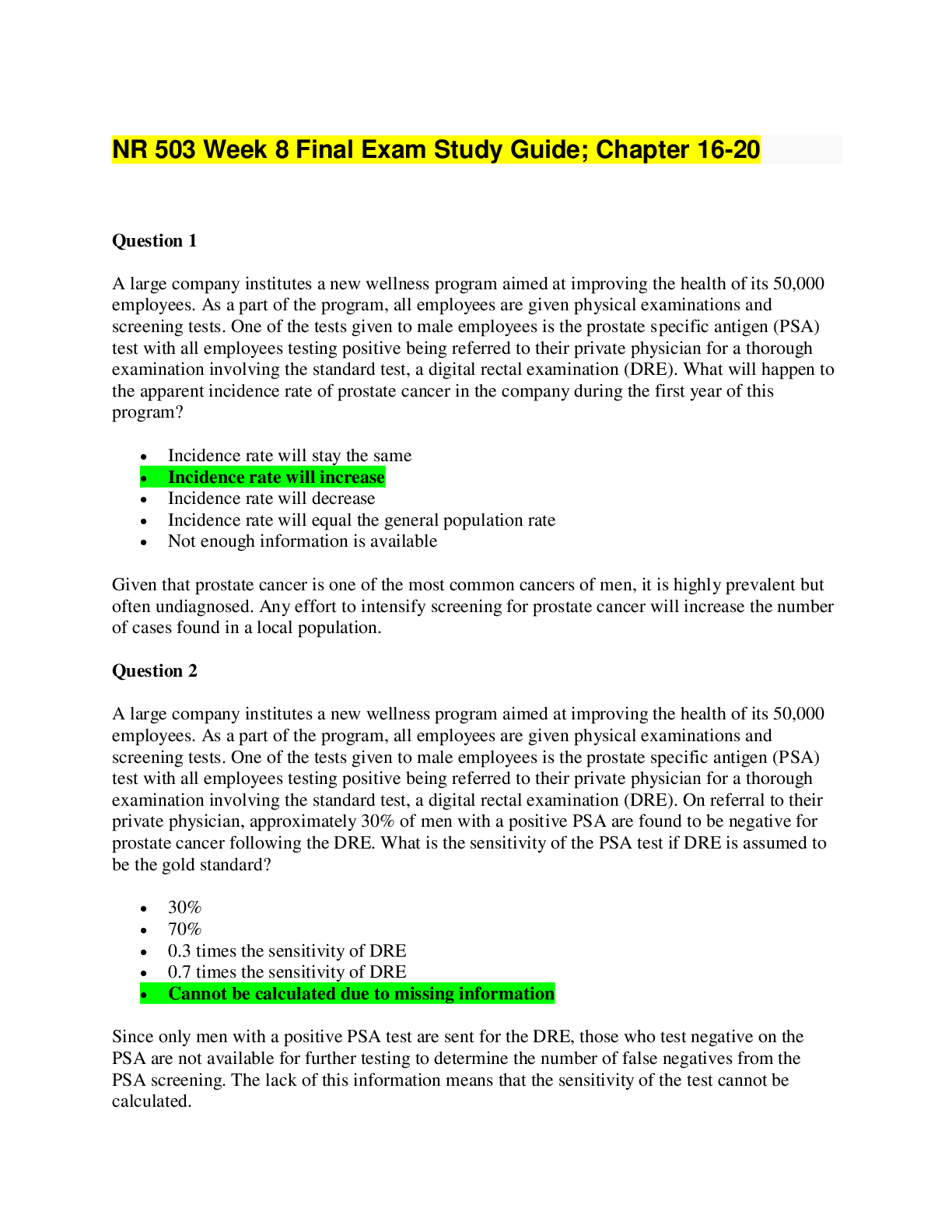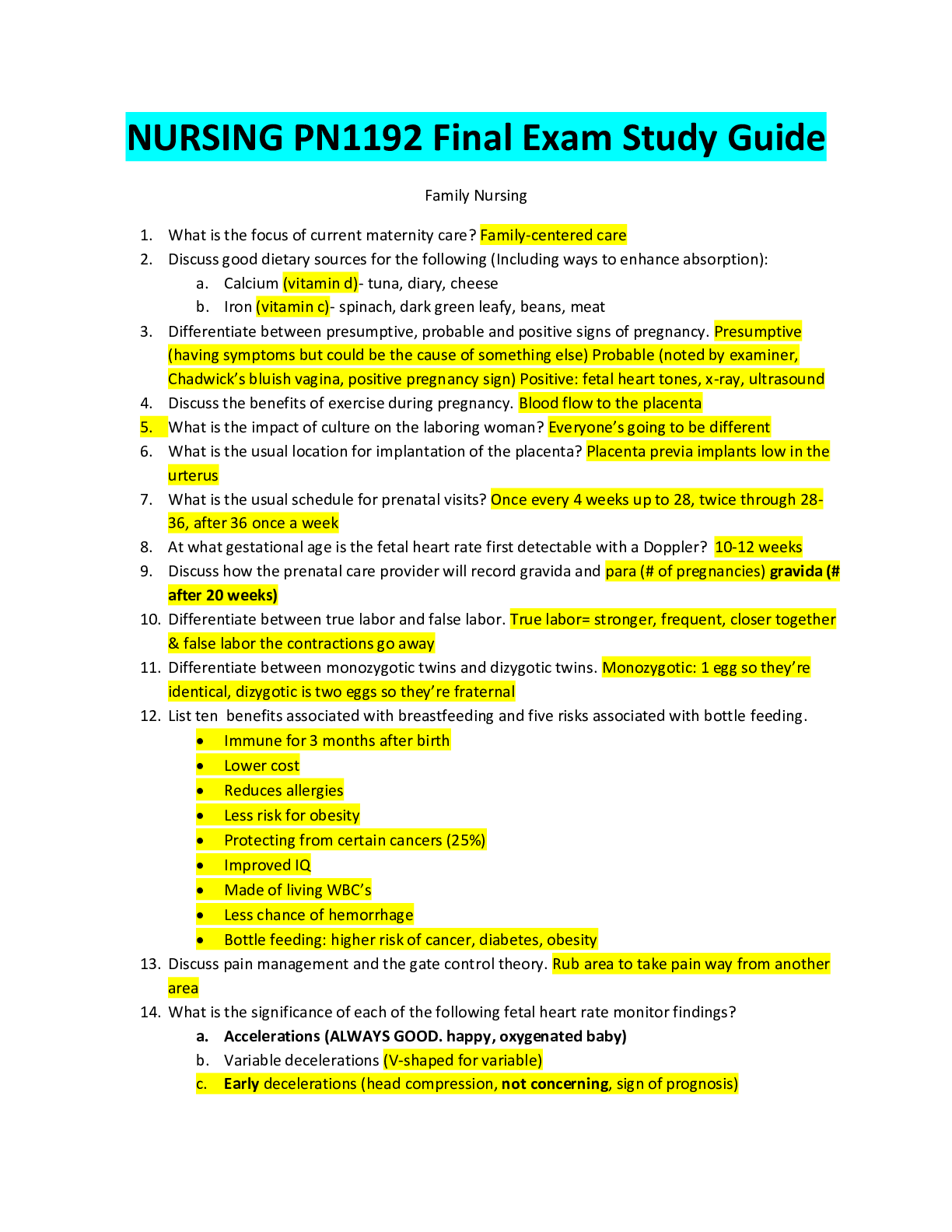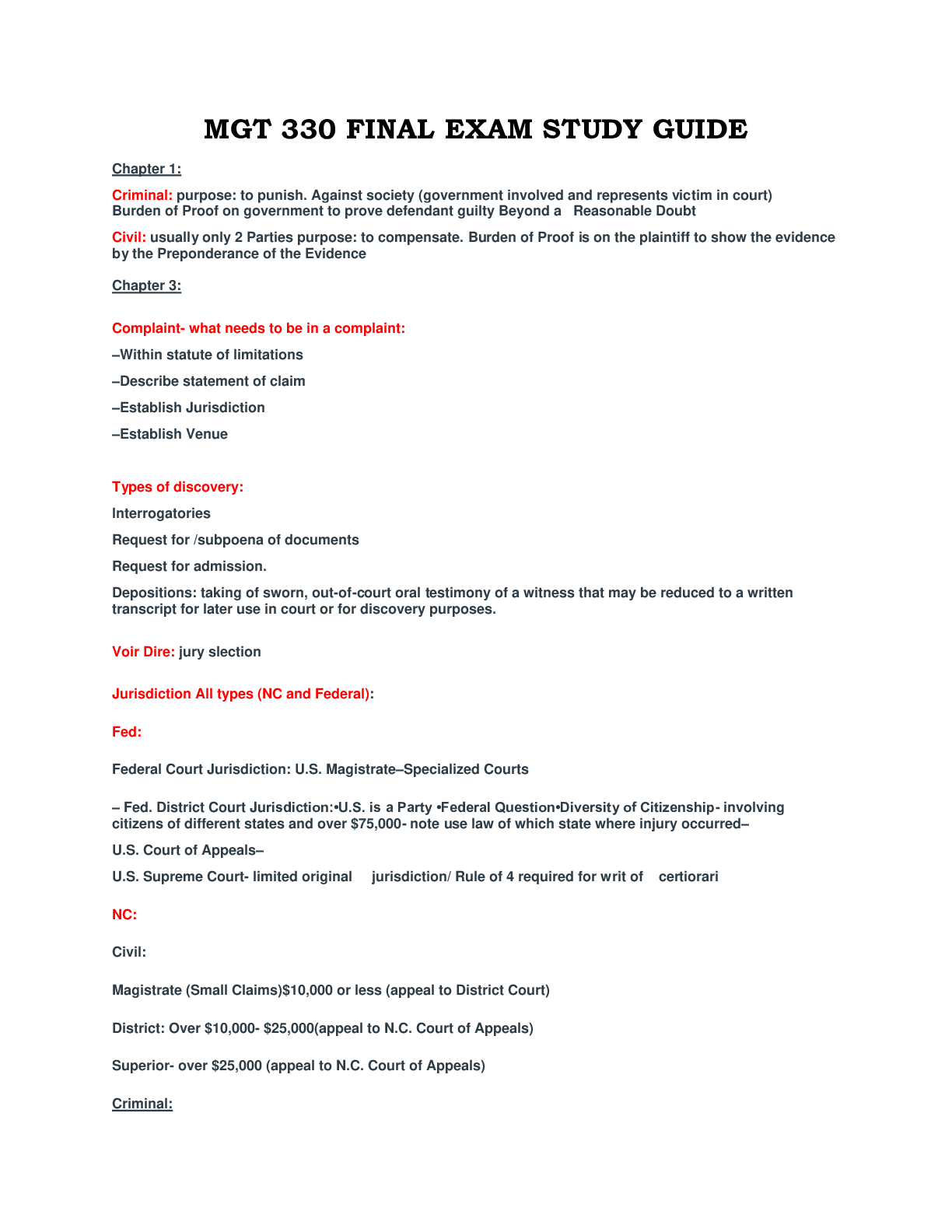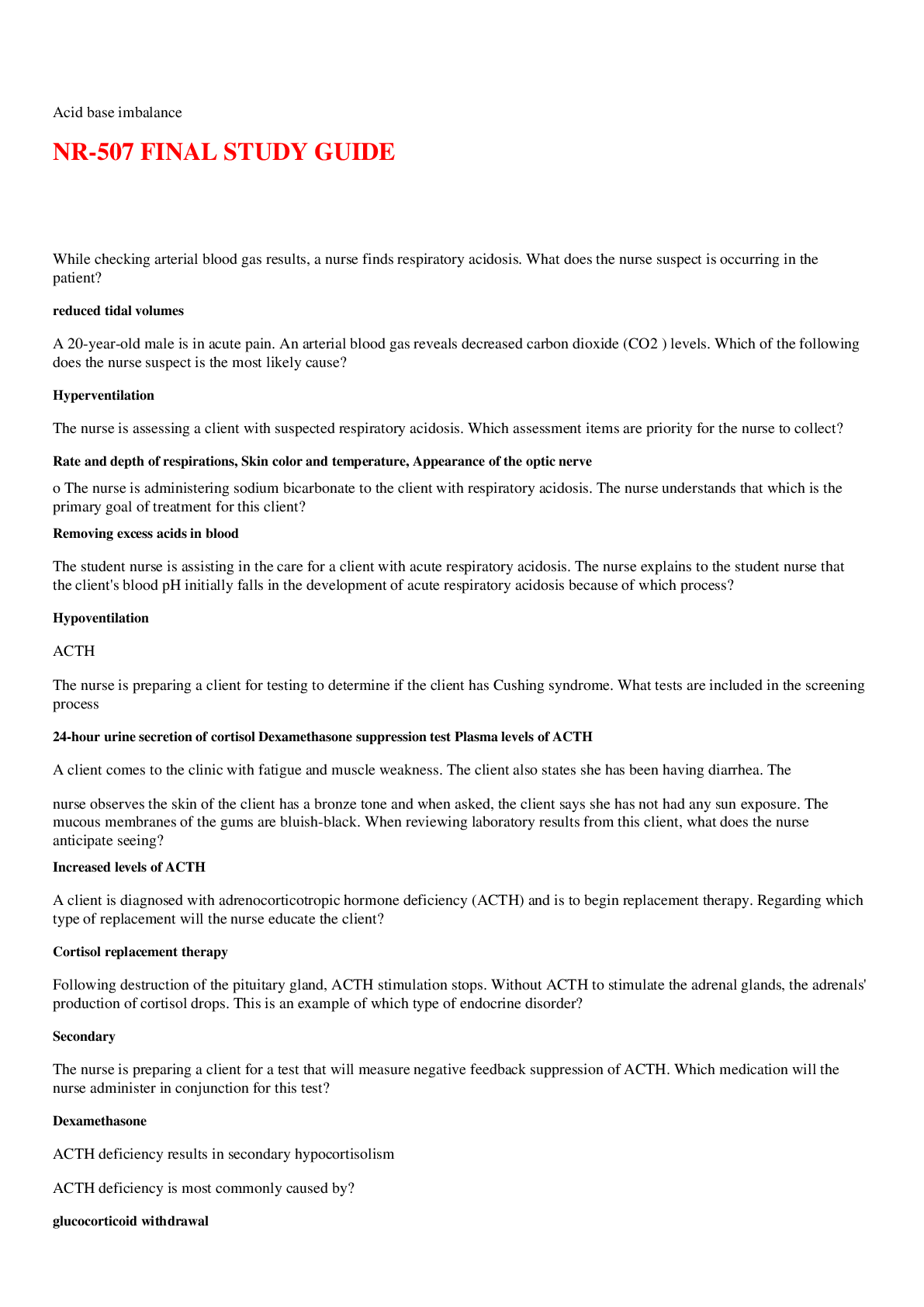Education > QUESTIONS & ANSWERS > BSW License Exam Study Guide with complete solutions (All)
BSW License Exam Study Guide with complete solutions
Document Content and Description Below
The Biological Person - ANSWER The body's biochemical, cell, organ, and physiological systems. Nervous system, endocrine system, immune system, cardiovascular system, musculoskeletal system, reproduct... ive system. The Psychological Person - ANSWER The mind and the mental processes. Cognition (conscious thinking processes), emotion (feelings), self (identity). The Spiritual Person - ANSWER The aspect of the person that searches for meaning and purpose in life, Themes of morality, ethics, justice, interconnectedness, creativity, mystical states, prayer, meditation and contemplation, relationships with a higher power. The Physical Environment: - ANSWER The natural and human-built material aspects of the environment. Water, sun, trees, buildings, landscapes. Culture - ANSWER A set of common understandings, evident in both behavior and material artifacts. Beliefs, customs, traditions, values. Social Institutions - ANSWER Patterned ways of organizing social relationships in a particular sector of social life, Family, religion, government, economy, education, social welfare, health care, mass media. Social Structure - ANSWER A set of interrelated social institutions developed by humans to impose constraints on human interaction for the purpose of the survival and well being of the collectivity. Social class. Dyads - ANSWER Two persons bound together in some way. Parent and child, romantic couple, social worker and client. Families - ANSWER Groupings of two or more people who define themselves as family and assume obligations to one another. Nuclear family, extended family, fictive kin. Small Group - ANSWER Collections of people who interact with each other, perceive themselves as belonging to a group, are interdependent, join together to accomplish a goal, fulfill a need through joint association or are influenced by a set of rules and norms. Friendship group, self help group, therapy group, committee task group, interdisciplinary team. Formal Organizations - ANSWER Collectivities of people, with a high degree of formality of structure, working together to meet a goal or goals. Civic and social service organizations, business organizations, professional associations. Communities - ANSWER People bound either by geography or by network links (webs of communication), sharing common ties, and interacting with one another. Territorial communities such as neighborhoods, relational communities such as the social work community, the disability community, a faith community, a soccer league. Social Movements - ANSWER Large scale collective actions to make change or resist change, in specific social institutions, Civil rights movement, poor people's movements, disability movement, gay rights movement. Trends - ANSWER Long term patterns of change that move in a general direction. Trend toward greater ethnic diversity in the United States, trend toward delayed childbearing in advanced industrial countries, trend toward greater income inequality between sub-Saharan Africa and the rest of the world. Cycles - ANSWER Short term patterns of change that reverse direction repetitively. A weekly cycle of work interspersed with rest and relaxation. Economic downturns and upturns. Shifts - ANSWER Sudden abrupt changes of direction. Changes in patterns of living following a major loss. Changes in the physical and social environment following a natural disaster (hurricane, flood, earthquake) or human made disaster such as September 11, 2001. Linear Time - ANSWER Time in terms of a straight line. Past, present, future. Acculturation - ANSWER A process of changing one's culture by incorporating elements of another culture. Service - ANSWER Social worker's primary goal is to help people in need and to address social problems. Social workers elevate service to others above self interest. Social workers draw on their knowledge, values, and skills to help people in need and to address social problems. Social workers are encouraged to volunteer some portion of their professional skills with no expectation of significant financial return. Social Justice - ANSWER Social workers challenge social justice. Social workers pursue social change, particularly with and on behalf of vulnerable and oppressed individuals and groups of people. Social workers' social change efforts are focused primarily on issues of poverty, unemployment, discrimination, and other forms of social injustice. These activities seek to promote sensitivity to needed information, services, and resources; equally of opportunity and meaningful participation in decision making of people. Dignity and Worth of the Person - ANSWER Social workers respect the inherent dignity and worth of the person. Social workers treat each person in a caring and respectful fashion, mindful of individual differences and cultural and ethnic diversity. Social workers promote clients' socially responsible self determination. Social workers are cognizant of their dual responsibility to clients and to the broader society. They seek to resolve conflicts between clients' interests and the broader society's interests in a socially responsible manner consistent with the values, ethical principles, and ethical standards of the profession. Importance of Human Relationship - ANSWER Social workers recognize the central importance of human relationships. Social workers understand that relationships between and among people are an important vehicle for change. Social workers engage people as partners in the helping process. Social workers seek to strengthen relationships among people in a purposeful effort to promote, restore, maintain, and enhance the well being of individuals, families, social groups, organizations, and communities. Integrity - ANSWER Social workers behave in a trustworthy manner, Social workers are continually aware of the profession's mission, values, ethical principles, and ethical standards and practice in a manner consistent with them. Social workers act honestly and responsibly and promote ethical practices on the part of the organizations with which they are affiliated. Competence - ANSWER Social workers practice within their areas of competence and develop and enhance their professional expertise. Social workers continually strive to increase their professional knowledge and skills and to apply them in practice. Social workers should aspire to contribute to the knowledge base of the profession. Infancy - ANSWER Trust versus Mistrust, Maternal persons Early Childhood - ANSWER Autonomy versus Shame and Doubt, Parental persons Play Age - ANSWER Initiative versus Guilt, Family School Age - ANSWER Industry versus Inferiority, Neighborhood Adolescence - ANSWER Identity versus identity diffusion, Peers Young Adulthood - ANSWER Intimacy versus Isolation, Partners Adulthood - ANSWER Generativity versus Self absorption, Household Mature Age - ANSWER Integrity versus Disgust and Despair, Humanity Microsystems - ANSWER Systems that involve direct face to face contact between members. Mesosystems - ANSWER Networks of microsystems of a given person. Exosystems - ANSWER The linkages between microsystems and larger institutions that affect the system such as the family system and the parent's workplace or the family system and the child's school. Macrosystems - ANSWER The broader influences of culture, subculture, and social structure. Assumptions - ANSWER Beliefs held to be true without testing or proof, about the nature of human social life. Biopsychosocial approach - ANSWER Human behavior is considered to be the result of interactions of integrated biological, psychological, and social systems. Psychology is seen as inseparable from biology; emotions and cognition affect the health of the body and are affected by it. Increasingly, neurobiologist write about the "social brain", recognizing that the human brain is wired for social life but also recognizing that the social environment has an impact on brain structure and processes. Concepts - ANSWER Constants - ANSWER Move invariably in one direction; the aging process. Constructivist Perspective - ANSWER Deductive Reasoning - ANSWER Meaning that theories lay out general, abstract propositions that we can use to generate specific hypothesis to test in unique situations. Determinism - ANSWER Human behavior determined by forces beyond the control of the person. Dimension - ANSWER Refers to a feature that can be focused on separately but that cannot be understood without also considering other features. Diversity - ANSWER Empirical Research - ANSWER A careful, purposeful, and systematic observation of events with the intent to note and record them in terms of their attributes, to look for patterns in those events, and to make our methods and observations public. Heterogeneity - ANSWER Refers to individual level orientation differences among individuals. Hypothesis - ANSWER Tentative statements, to be explored and tested, not facts to be applied, in transactions with the person. Interpretist Perspective - ANSWER Assumption that reality is based on people's definitions of it and research should focus on learning the meanings that people give to their situations. Also referred to as constructivist perspective. Life Course Perspective - ANSWER Assumes that each person's life has a unique long-term pattern of stability and change but that shared social and historical contexts produce some commonalities. Life Events - ANSWER Brief events or incidents; they may produce shifts and have serious and long-lasting effects. Multi-determined - ANSWER Human behavior is developed as a result of many causes. Multidimensional Approach - ANSWER Thinking about human behavior as changing configurations of person and environment over time. Objective Reality - ANSWER Dimensions of human behavior that exist outside of a person's consciousness. Positivist Perspective - ANSWER The world has an order that can be discovered; findings of one study should be applicable to other groups; complex phenomena can be studied by reducing them to some component part; findings are tentative and subject to question; scientific methods are value-free. Post-positivism - ANSWER Privilege - ANSWER Unearned advantage, for some groups and disadvantage for other groups. Propositions - ANSWER Theoretical concepts are put together to form assertions. Qualitative Methods of Research - ANSWER Designed to capture how participants view social life rather than to ask participants to respond to categories preset by the researcher. Quantitative Methods of Research - ANSWER Use quantifiable measures of concepts, standardize the collection of data, attend only to preselected variables, and use statistical methods to look for patterns and associations. Subjective Reality - ANSWER Reality based on personal perception. Theory - ANSWER A logically interrelated set of concepts and propositions, organized into a deductive system, which explains relationships between aspects of our world. Time Orientation - ANSWER Describes the extent to which individuals and Collectivities are invested in three temporal zones- past, present, and future. Voluntarism - ANSWER Persons are free and proactive agents in the creation of their behavior. Agency - ANSWER Boundary - ANSWER Indicating who is in and who is out. Chaos Theory - ANSWER Emphasize systems processes that produce change, even sudden, rapid, radical change. Recognizes negative feedback loops as important processes in systems and recognizes their role in promoting system stability. Proposes that complex systems produce positive feedback loops that feed back information about deviation or should we say innovation, into the steady state in such a way that deviation reverberates throughout the system and produces change sometimes even rapid change. Classical conditioning theory - ANSWER Cognitive social learning theory - ANSWER Conflict Perspective - ANSWER Drawing attention to conflict, dominance, and oppression in social life; typically looks for sources of conflict and causes of human behavior in the economic and political arenas, and more recently in the cultural arena. Critical Theorists - ANSWER Developmental perspective - ANSWER Focuses on how human behavior unfolds across the life course. Human development occurs in clearly defined stages and is seen as a complex interaction of biological, psychological, and social processes. Ecomaps - ANSWER Efficacy Expectation - ANSWER An expectation that one can personally accomplish a goal. Empowerment Theories - ANSWER Focus on processes by which individuals and collectivities can recognize patterns of inequality and injustice and take action to increase their own power. Feedback Mechanism - ANSWER The processes by which information about past behaviors in a system are fed back into the system in a circular manner. Feminist Theories - ANSWER Focus on male domination of the major social institution and present a vision of a just world based on gender equity. Hierarchy of Needs - ANSWER Suggests higher needs cannot emerge until lower needs have been satisfied. 1. Physiological needs: hunger, thirst, sex 2. Safety needs: avoidance of pain and anxiety; desire for security. 3. Belongingness and love needs: affection, intimacy 4. Esteem needs: self-respect, adequacy, mastery 5. Self-actualization: to be fully what one can be; altruism, beauty, creativity, justice Humanistic Perspective - ANSWER Include humanistic psychology and existential psychology, both of which emphasize the individual's freedom of action and search for meaning. Learned Helplessness - ANSWER A person's prior experience with environmental forces has led to low self-efficacy and expectations of efficacy. Operant Conditioning Theory - ANSWER Phenomenal Self - ANSWER The individual's subjectively felt and interpreted experience of "who I am". Pluralistic Theory of Social Conflict - ANSWER Psychodynamic Perspective - ANSWER Concerned with how internal processes such as needs, drives, and emotions motivate human behavior. Rational Choice Perspective - ANSWER Role - ANSWER The usual behaviors of persons occupying a particular social position. Self-efficacy - ANSWER A sense of personal competence. Social Behavioral Perspective - ANSWER Sometimes called the social learning perspective; suggests that human behavior is learned as individuals interact with their environments. Social Constructionist Perspective - ANSWER Focuses on how people learn, through their interactions with each other to classify the world and their place in the world. Social Exchange Theory - ANSWER Starts with the premise that social behavior is based on the desire to maximize benefits and minimize costs. Social Network Theory - ANSWER Has intellectual roots in the systems perspective. Provides useful tools for person-environment assessments and holds great promise for the future. Typically presented as socio-grams which illustrate the relations among network members-individuals, groups, organizations. Systems Perspective - ANSWER Sees human behavior as the outcome of reciprocal interactions of persons operating within linked social systems. Its roots are very interdisciplinary. Adaptation - ANSWER Afrocentric Relational Theory - ANSWER Assumes a collective identity for people rather than valuing individuality. Coping - ANSWER Our efforts to master the demands of stress. Crisis - ANSWER Daily Hassles - ANSWER Common occurrences that are taxing. Defense Mechanisms - ANSWER Unconscious, automatic responses that enable us to minimize perceived threats or keep them out of our awareness entirely. Emotion-Focused Coping - ANSWER To change either the way the stressful situation is attended to (by vigilance or avoidance) or the meaning to oneself of what is happening. The external situation does not change, but our behaviors or attitudes change with respect to it, and we may thus effectively manage the stressors. General Adaptation Syndrome - ANSWER Homeostasis - ANSWER A steady state of functioning; our body's attempts to maintain physical equilibrium. Neural Plasticity - ANSWER Object Relations Theory - ANSWER Personal Network - ANSWER Includes those from the social network who, in our view, provide us with our most essential supports. Person-In-Environment - ANSWER Formally organizes the assessment of individual's ability to cope with stress around social functioning problems, environmental problems, mental health problems, and physical health problems. Posttraumatic Stress Disorder - ANSWER Persistent reliving of traumatic event, persistent avoidance of stimuli associated with the traumatic event, persistent high state of arousal. Problem-Focused Coping - ANSWER To change the situation by acting on the environment. Tends to dominate whenever we view situations as controllable by action. Relational Coping - ANSWER Takes into account actions that maximize the survival of others- such as our families, children, and friends- as well as ourselves. Role Strain - ANSWER Social Identity Theory - ANSWER Social Network - ANSWER Includes not just our social support but all the people with whom we regularly interact and the patterns of interaction that result from exchanging resources with them. Social Support - ANSWER The interpersonal interactions and relationships that provide us with assistance or feelings of attachment to persons we perceive as caring. State - ANSWER A process that changes over time depending on the context. Stress - ANSWER Any event in which environmental or internal demands tax the adaptive resources of an individual. May be biological (a disturbance in bodily systems), psychological (cognitive and emotional factors involved in the evaluation of a threat), and even social (the disruption of a social unit). Stress/Diathesis Models - ANSWER Trait - ANSWER Traumatic Stress - ANSWER Refers to events that involve actual or threatened severe injury or death, of oneself or significant others; natural, technological, and individual. Behavior Settings - ANSWER Behavior is always tied to a specific place. Behavior Settings Theories - ANSWER Consistent, uniform patterns of behavior occur in particular places of behavior settings. Biophilia - ANSWER Humans have a genetically based need to affiliate with nature. Boundary Regulating Mechanisms - ANSWER Personal space and territoriality- we use to gain greater control over our physical environments. Built Environment - ANSWER The portion of the physical environment attributable solely to the human effort. Control Theories - ANSWER Focus on the issue of how much control we have over our physical environments and the attempts we make to gain control; privacy, personal space, territoriality, and crowding. Crowding - ANSWER The subjective feeling of having too many people around. Defensible space - ANSWER Theory that suggests residential crime and fear of crime can be decreased by means of certain design features that increase resident's sense of territoriality and consequently, their motivation to watch out for the neighborhood. Density - ANSWER The ration of persons per unit area of space. Natural Environment - ANSWER The portion of the environment influenced primarily by geological and nonhuman biological forces- for both you and your clients. Personal Space - ANSWER Interpersonal distance, the physical distance we choose to maintain in interpersonal relationships. Place Attachment - ANSWER The process in which people and groups form bonds with places. Place Identity - ANSWER When a particular place becomes an important part of our self-identity; merger of place and self. Can develop when there is strong negative, as well as positive place attachment. Primary Territory - ANSWER Territory that evokes feelings of ownership that we control on a relatively permanent. basis and that is vital to our daily lives. Accommodation - ANSWER The process of partial or selective cultural change. Acculturation - ANSWER A mutual sharing of culture. Assimilation - ANSWER The process in which the cultural uniqueness of the minority is abandoned and its members try to blend invisibly into the dominant culture. Bicultural Socialization - ANSWER Involves a non-majority group or member mastering both the dominant culture and their own. Biological Determinism - ANSWER The attempt to differentiate social behavior on the basis of biological and genetic endowment. Common Sense - ANSWER What people have come to believe everyone in a community or society should know and understand as a matter of ordinary, taken for granted social competence. Cultural Conflict - ANSWER The symbols we use are arbitrary. They can mean one thing to you and something different to others. Cultural Innovation - ANSWER Culture is not static; it is adapted, modified, and changed through interactions over time. Cultural Relativism - ANSWER Makes few rankings of inferiority and superiority; frames contemporary multiculturalism. Culture - ANSWER Culture of Poverty - ANSWER Originally used to bring attention to the way of life developed by poor people to adapt to the difficult circumstances of their lives. Customs - ANSWER Cultural practices. Ethnic Identity - ANSWER How ethnic groups define themselves and maintain meaning for living individually and as a group. Ethnocentrism - ANSWER Tendency to elevate our own ethnic group and its social and cultural processes over others. Ethos - ANSWER The tone, character, and quality of people's life, its moral and aesthetic style and mood; it is the underlying attitude toward themselves and their world that life reflects. Hegemony - ANSWER Dominance of a particular way of seeing the world. Ideology - ANSWER The dominant ideas about the way things are and should work. Postmodernism - ANSWER The term many people use to describe contemporary culture. They suggest that global electronic communications are the foundation of postmodern culture, exposing people in advanced capitalist societies to media images that span place and time and allow them to splice together cultural elements from these different times and places. Practice Orientation - ANSWER Explain what people do as thinking, intentionally acting persons who face the impact of history and the restraints of structures that are embedded in our society and culture. Asks how social systems shape, guide, and direct people's values, beliefs, and behavior. Asks how people, as human actors or agents, perpetuate or shape social systems. Race - ANSWER First and foremost a system of social identity. Racism - ANSWER The term for thinking and acting as if phenotype and these other capacities are related and imply inferiority or superiority. Socioeconomic Status - ANSWER A dirty word among people in the US, who generally believe that any class differences that may exist are of one's own making. Class differences do exist and they document another form of cultural inequality, as well as imperfections in our capitalist economic system. Symbol - ANSWER Something verbal or nonverbal that comes to stand for something else. Traditions - ANSWER Cultural beliefs and practices so taken for granted that they seem inevitable parts of life. Worldview - ANSWER An idea of reality, a concept of nature, of self, of society. Strengths Perspective - ANSWER Identifying strengths can change the social worker's view of where to begin and create a hopefulness about the future so that the climate changes from one of despair over an overwhelming multiplicity of problems to an appreciation of how the family meets challenges to the best of its ability. Triangulation - ANSWER Occurs when two family members inappropriately involve another family member to reduce the anxiety in the dydadic relationships. Married couple struggling with marital problems, focusing on child's school problems instead to relieve the tension in the marital relationship. Linear Time - ANSWER Future time. Cycles - ANSWER Reverse direction repetitively; daily, weekly, monthly, seasonally, annually, or in some other regular or partially regular pattern. Trends - ANSWER Move in a general direction but are not as invariable as constants. Shifts - ANSWER Sudden abrupt changes in direction. / Cognition - ANSWER Conscious or preconscious thinking processes- the mental activities of which we are aware or can become aware with probing. Psychology - ANSWER Mind and mental processes. Emotion - ANSWER A feeling state characterized by our appraisal of a stimulus, by changes in bodily sensations, and by displays of expressive gestures. Affect - ANSWER Often used interchangeably with emotion; but refers only to the physiological manifestations of feelings. Unconscious - ANSWER Those feelings of which we are not aware but which influence our behavior. Mood - ANSWER A feeling disposition that is more stable than emotion, less intense, and less tied to a specific situation. Schema - ANSWER An internalized representation of the world or an ingrained ands systematic pattern of thought, action, and problem solving. Emotional Intelligence - ANSWER A person's ability to process information about emotions accurately and effectively and consequently to regulate emotions in an optimal manner. It includes self-control, zest and persistence, ability to motivate oneself, ability understand and regulate one's own emotions, and ability to read and deal effectively with other people's feelings. [Show More]
Last updated: 1 year ago
Preview 1 out of 14 pages
Instant download
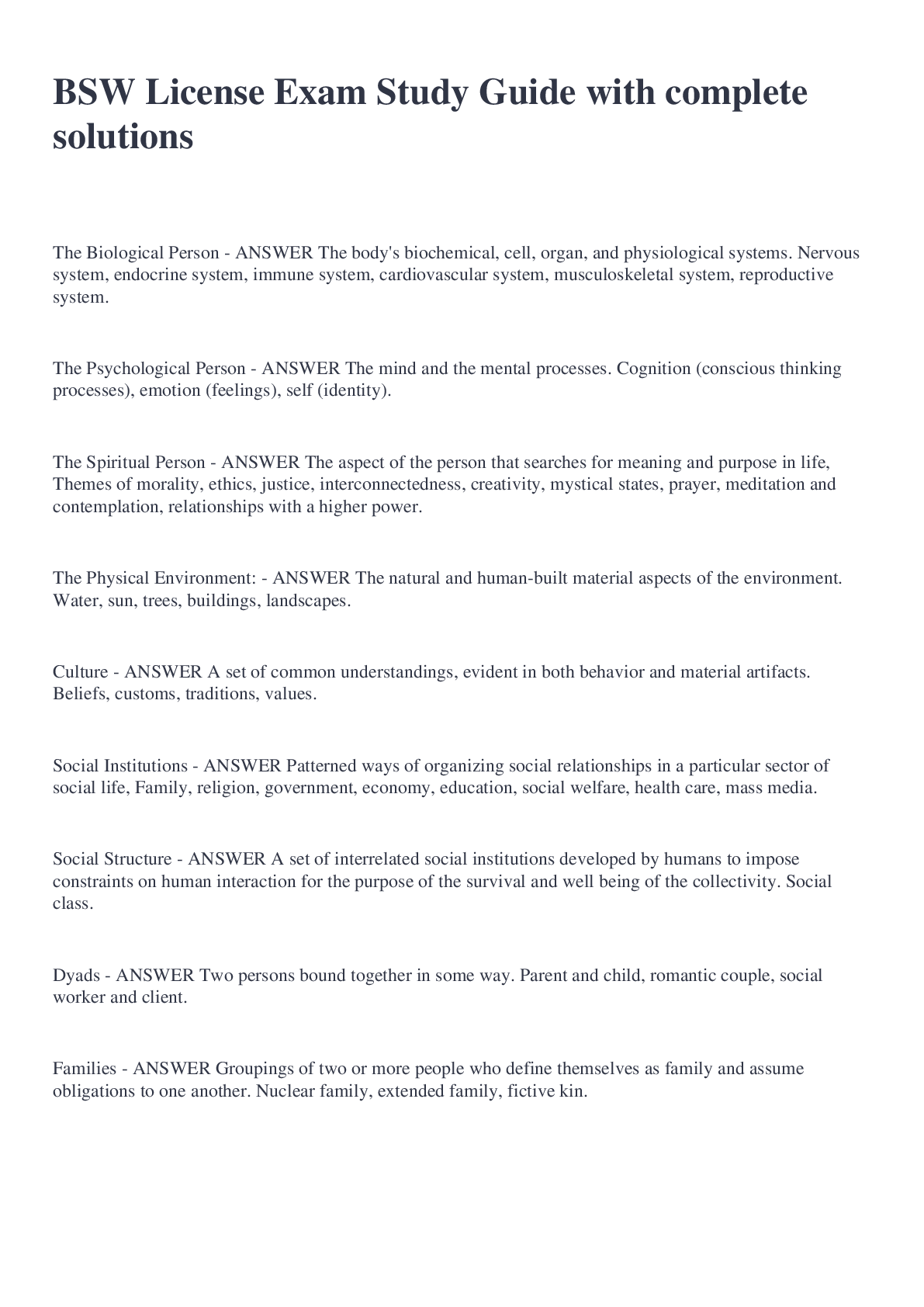
Buy this document to get the full access instantly
Instant Download Access after purchase
Add to cartInstant download
Reviews( 0 )
Document information
Connected school, study & course
About the document
Uploaded On
Aug 16, 2022
Number of pages
14
Written in
Additional information
This document has been written for:
Uploaded
Aug 16, 2022
Downloads
0
Views
41

